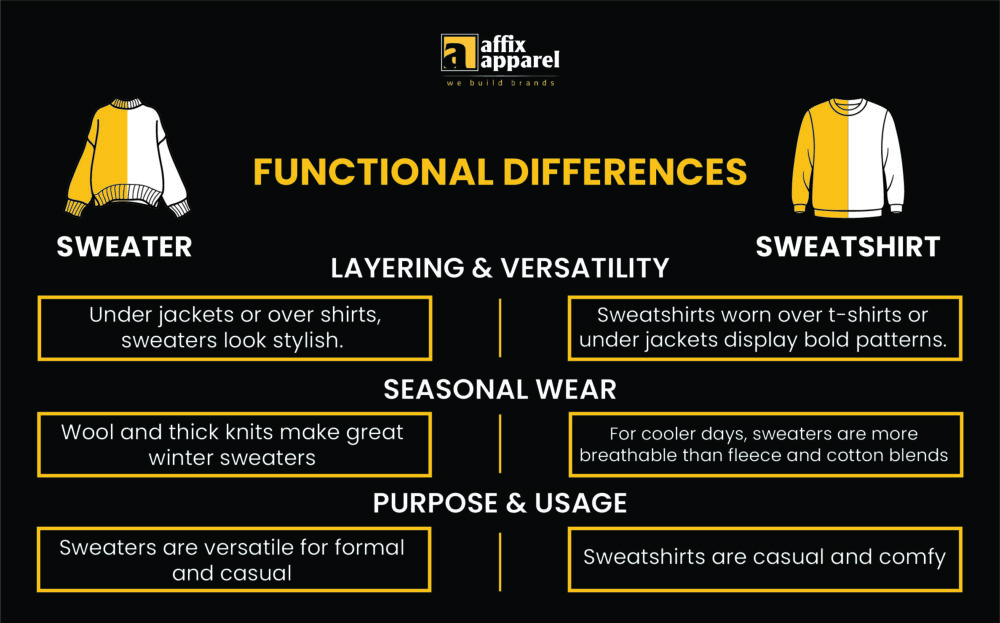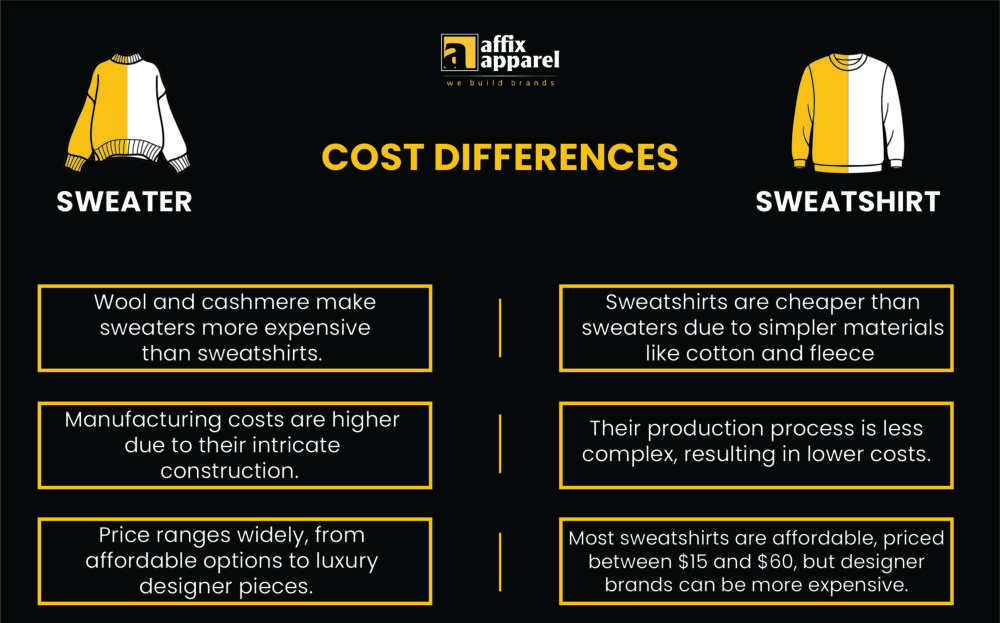Have you ever pondered what truly sets a sweater apart from a sweatshirt? This is a question that often arises in the world of fashion, and understanding the distinction can have a significant impact on your clothing brand. While both garments are designed to keep you warm and are perfect for colder climates, they each possess unique characteristics in terms of design and purpose. In this blog post, we’ll delve into the key differences between sweaters and sweatshirts, helping you make informed decisions for your next clothing line! Both sweatshirts and sweaters excel at keeping you warm, but the term "sweat" in their names stems from their origins as cotton practice jerseys used in sports. Given their shared history, they’re often confused for one another. However, grasping the fundamental differences between the two is crucial for any clothing brand aiming to cater to diverse audiences. If you’ve ever wondered, “What exactly is a sweatshirt?†it’s a casual, comfy piece of clothing commonly associated with sportswear. Typically made from fleece or cotton blends, sweatshirts are crafted to prioritize comfort and ease of use. Fleece, with its soft insulating properties, excels in cold weather, while cotton blends ensure a breathable and lightweight feel. As for whether a hoodie is a type of sweatshirt, the answer is yes! Sweatshirts come in various styles, including hoodies with a front pocket and a hood, as well as crewnecks featuring a round neckline without a collar. Known for their relaxed fit, these garments are perfect for lounging, exercising, or embracing a laid-back aesthetic. For more insights, check out our guide on Types Of Material For A Hoodie - Choosing The Right Fabric. Here’s where things get interesting. A sweater is essentially a knitted piece of clothing primarily designed to keep you warm. Made from wool, cotton, or synthetic materials, sweaters are versatile and available in countless styles. Wool remains the classic choice, renowned for its excellent insulation, while cotton offers a lighter, more breathable alternative. Synthetic fibers can enhance durability and flexibility. Ever wondered, “Is a pullover the same as a sweater?†The answer is yes—regular sweater styles include cardigans, which open at the front and fasten with buttons, and pullovers, which are simply pulled over the head. Sweaters vary in weight, ranging from light to chunky, making them suitable for both casual and formal settings. For more details, explore our article on Explore The Cardigan – 12 Different Types of Cardigans. Grasping the distinctions in design and construction between sweaters and sweatshirts is vital for any fashion brand. These differences affect not only the appearance and functionality of the garments but also their appeal to consumers. From the materials used to the construction techniques and resulting style and fit, every aspect plays a critical role in defining these popular clothing items. One of the most obvious contrasts between sweaters and sweatshirts lies in the materials used. Sweaters are typically crafted from natural materials such as wool, cotton, or synthetic fabrics like acrylic. These fabrics lend sweaters a cozy, snug feel, making them ideal for cold weather. Such materials tend to be bulkier and more robust, offering superior insulation. In contrast, sweatshirts are usually made from a blend of cotton or fleece fabric. These garments are softer and lighter, providing a relaxed and casual vibe. Sweatshirts are designed to allow airflow and wick moisture away, making them perfect for both leisure and athletic activities. Sweaters and sweatshirts differ significantly in style and fit, as well as their intended purposes. Sweaters often feature a more tailored fit, available in styles like cardigans, pullovers, and turtlenecks. This versatility allows them to transition seamlessly from casual to formal settings. They can be layered over shirts for a polished look or worn alone for comfort and coziness. On the other hand, sweatshirts are known for their loose, relaxed fit, commonly seen in styles like hoodies and crewnecks. These garments are perfect for casual outings, sports, or simply lounging at home. When designing your clothing line, consider the specific fashion needs and events to determine which styles align with your brand’s vision. The manufacturing methods used in creating sweaters and sweatshirts, such as knitting and weaving, significantly impact their texture and appearance. Most sweaters are made through knitting, which involves interlocking loops of yarn to form a flexible, stretchy material. This technique results in a variety of textures and patterns, making sweaters ideal for both casual and formal occasions. Meanwhile, sweatshirts are produced using weaving, where threads cross at right angles to create a fabric that’s firmer and more structured. This approach yields a smoother, denser texture, ideal for garments focused on comfort and durability. Deciding whether to knit or weave a garment ultimately influences its flexibility, warmth, and overall style. Every piece of clothing has unique advantages and fulfills specific needs, whether it’s seasonal wear, adaptability, or practical usage. This section will explore the functional differences between sweaters and sweatshirts, shedding light on their optimal applications in various scenarios. Both sweaters and sweatshirts are highly versatile when it comes to layering. Sweaters can be worn under jackets or over shirts to create a cohesive, stylish look suitable for both casual and semi-formal events. Their variety of styles, such as cardigans and pullovers, makes them easy to pair with other clothing items. Sweatshirts, with their relaxed and cozy vibe, are perfect for layering over t-shirts or under jackets. They’re ideal for a casual, sporty look and can make a strong statement when adorned with bold designs or logos. For more insights, read our article on Coat vs Jacket: How To Know The Difference. When it comes to seasonal clothing, sweaters and sweatshirts serve different purposes. Compared to sweatshirts, sweaters are better suited for colder seasons due to their materials like wool or thick knits, which provide excellent insulation. They’re ideal for staying warm during autumn and winter. On the flip side, sweatshirts, typically crafted from fleece or cotton blends, are more versatile and suitable for varying climates. While they offer warmth, they’re lighter and more breathable, making them ideal for cooler spring and autumn days, as well as chilly summer nights. Many people wonder, “Are sweaters and sweatshirts the same?†While they share similarities, they serve different purposes. Sweaters are incredibly versatile, effortlessly transitioning between casual and formal events. They’re adaptable enough to be worn for work, dinner parties, or casual gatherings, making them a staple in many wardrobes. Their intricate knitting adds elegance, making them suitable for both everyday wear and formal occasions. In contrast, sweatshirts are closely tied to casual and sporty attire. They’re perfect for relaxation, running errands, or engaging in physical activities. Designed with a loose fit and comfort in mind, sweatshirts are ideal for casual wear and athleisure. Several factors, including materials, brand positioning, and manufacturing costs, contribute to the price differences between sweaters and sweatshirts. Sweaters tend to be more expensive than sweatshirts due to the materials and craftsmanship involved. High-end sweaters are often made from premium fabrics like wool, cashmere, or merino, which are more costly than the typical cotton or polyester blends found in sweatshirts. The process of making sweaters involves more manual labor and time, driving up production costs. In addition, sweaters frequently incorporate elaborate designs, patterns, and embellishments, which can further increase their price. As a result, sweaters span a wide range of retail prices, from budget-friendly options around $10-$50 to luxury pieces that can cost several hundred dollars or more. Sweatshirts are generally more affordable than sweaters due to their simpler materials and construction. Most sweatshirts are made from cotton, fleece, or synthetic blends, which are more economical compared to the wool or cashmere used in many sweaters. The production process for sweatshirts is typically simpler and less expensive. Furthermore, sweatshirts often emphasize a more casual, functional style, reducing production costs. While designer or branded sweatshirts may carry a higher price tag, most fall within the range of $15 to $60, making them accessible to the average consumer. However, exclusive or premium sweatshirts from renowned brands can exceed $100 in price. Knowing how to properly care for your sweaters and sweatshirts is essential for maintaining their appearance and comfort over time. Let’s explore the care instructions for both. Taking proper care of sweaters is crucial to preserving their quality. Sweaters made from delicate fabrics like wool or cashmere require special attention. Hand-washing in cold water with a mild detergent is recommended to prevent shrinkage and keep the fabric soft. Avoid twisting the garment to remove water; instead, gently squeeze out moisture with a towel and lay it flat to dry. If machine washing is necessary, use a gentle cycle and place the sweater in a mesh laundry bag. Fold sweaters neatly and store them in a cool, dry place to avoid stretching. Cedar balls or lavender sachets can help deter moths, and regularly airing out sweaters can keep them fresh. Using a fabric shaver to remove pills ensures your sweaters stay soft and stylish for years. Sweatshirts are relatively low-maintenance compared to sweaters but still require proper care. To maintain their quality, wash them in a washing machine with cold water and a gentle detergent, turning them inside out to protect prints. Avoid using bleach to prevent damage or discoloration. Allow sweatshirts to air dry flat or hang them, or use a low-heat dryer setting if needed. Fold sweatshirts neatly and store them in a cool, dry area away from direct sunlight. Place tissue paper between folds to protect delicate prints. Use a fabric shaver to remove pills and keep your sweatshirts looking vibrant and comfortable for longer. Understanding the differences between sweaters and sweatshirts is essential when building a successful clothing brand. Sweaters offer warmth, versatility, and style, making them suitable for a wide range of occasions. Sweatshirts, on the other hand, prioritize comfort and casual wear. When designing your collection, consider your target audience, brand goals, and desired aesthetic. By recognizing the unique features of each garment, you can make informed decisions that align with your brand’s vision and customer preferences. Whether you want your clients to feel cozy and active or elegant and sophisticated, Affix Apparel offers top-notch custom clothing manufacturing services to bring your ideas to life. Microfiber Gym Towel,Microfiber Towel,Microfiber Fitness Towel,Microfiber Exercise Towel suzhou bangneng textile co.,ltd , https://www.bangnengtowel.comSweatshirt vs Sweater: The Core Distinction
Defining the Sweatshirt

Deciphering the Sweater

Design and Construction Differences
Fabric and Material Differences
Style and Fit
Knitting vs Weaving
Functional Differences

Layering and Versatility
Seasonal Wear
Purpose and Usage
Cost Differences

Cost of Sweaters
Cost of Sweatshirts
Care Instructions
Care Instructions for Sweaters
Care Instructions for Sweatshirts

Planning Your Next Clothing Line: Sweaters vs Sweatshirts